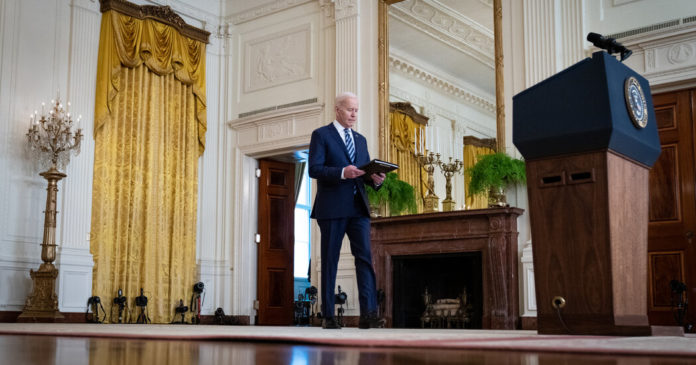
The Biden administration on Thursday announced a series of restrictions aimed at cutting off Russia’s access to foreign products like semiconductors, computers, lasers and telecommunications equipment in response to its invasion of Ukraine.
The measures, which analysts called significant, will halt direct technological exports from the United States to Russia, in an effort to curtail Russian industries including defense, aerospace and shipping. They also go beyond previous sanctions issued by the U.S. government by placing new limitations on products that are manufactured outside the United States but use American equipment or technology.
Under the new rules, high-tech goods that are made in foreign countries using American machinery, software or blueprints cannot be exported to Russia — restrictions that echo the kind of punitive curbs the United States imposed on the Chinese telecom firm Huawei in 2020.
“This is going to impose severe cost on the Russian economy, both immediately and over time,” President Biden said on Thursday.
“We have purposefully designed these sanctions to maximize a long-term impact on Russia and to minimize the impact on the United States and our allies,” he said.
Our Coverage of the Russia-Ukraine War
The Commerce Department, which announced the new restrictions, also added 49 entities linked to the Russian military to a government list that will face even further curbs on their access to foreign technology.
The rules were designed to exempt consumer electronics, like dishwashers, digital cameras and smartphones. But they will affect the supply of products in a range of industries, including aircraft, avionics, telecommunications, maritime, computers and microelectronics, said Kevin Wolf, a partner in international trade at Akin Gump who worked in export controls under the Obama administration.
“This is not just optics,” Mr. Wolf said. “It’s going to have a real, significant impact on these sectors of the Russian economy for many years.”
Allies in the European Union, Japan, Australia, the United Kingdom, Canada and New Zealand all announced plans to put into effect similar restrictions on technological exports, White House officials said.
In a briefing with reporters on Thursday, a senior administration official said that the Biden administration had been carrying out consultations with additional countries and that other governments were likely to announce parallel controls in the coming weeks or days.
The Biden administration would add further controls on Russia and any other countries that aided in its aggression if necessary, the official said.
Emily Kilcrease, a senior fellow at the Center for a New American Security said the new rules would probably usher in an immediate period of confusion and disruption, as companies try to figure out how to comply with the restrictions. But the real impact would be on the Russian economy and military capability over time. When electronics, airplanes and ships wear out, Russian entities will find themselves unable to buy new generations of technology.
“The ultimate effect of this is that it is freezing Russia’s technology stock where it is today,” Ms. Kilcrease said. “You can’t upgrade it, you can’t replace it, you can’t improve it.”
She added: “Once you get past this immediate confusion of how to comply with stuff, it’s really that long-term corrosive impact that’s going to be most detrimental to Russia.”
Other industry executives said that the immediate impact on global trade might be muted, since Russia is not a major global manufacturer or importer of technological goods.
John Neuffer, the president of the Semiconductor Industry Association, which represents the world’s major chipmakers, said that the industry was still evaluating the potential impact of the rules. But Russia, he said, was not a significant direct consumer of chips or of information technology equipment.
The broader Russian market for information and communication technology made up only about $25 billion of the multi-trillion-dollar global market in 2019, he said, citing figures from the International Data Corporation.
The measures arguably represented the most expansive and novel use to date of export controls, which have long been tailored to American-made exports of products that could be used against the United States by foreign militaries or terrorists.
In 2020, the United States revised its export control rules to better target Huawei. The new measures cut the Chinese company off not just from American goods, but also from products made in other countries with the help of U.S. technology, preventing it from buying chips on global markets and crippling its smartphone business.
Martin Chorzempa, a senior fellow at the Peterson Institute for International Economics, said those more expansive curbs had been “devastating” for Huawei. The new measures could prove effective against Russian industries, he said, though they would also add to complications for global firms that are already contending with soaring inflation and shipping delays.
“The cost is that you inject a lot of uncertainty into supply chains,” Mr. Chorzempa said. “Anytime these tools are super powerful, they also potentially upend some of the certainty that businesses rely on.”







